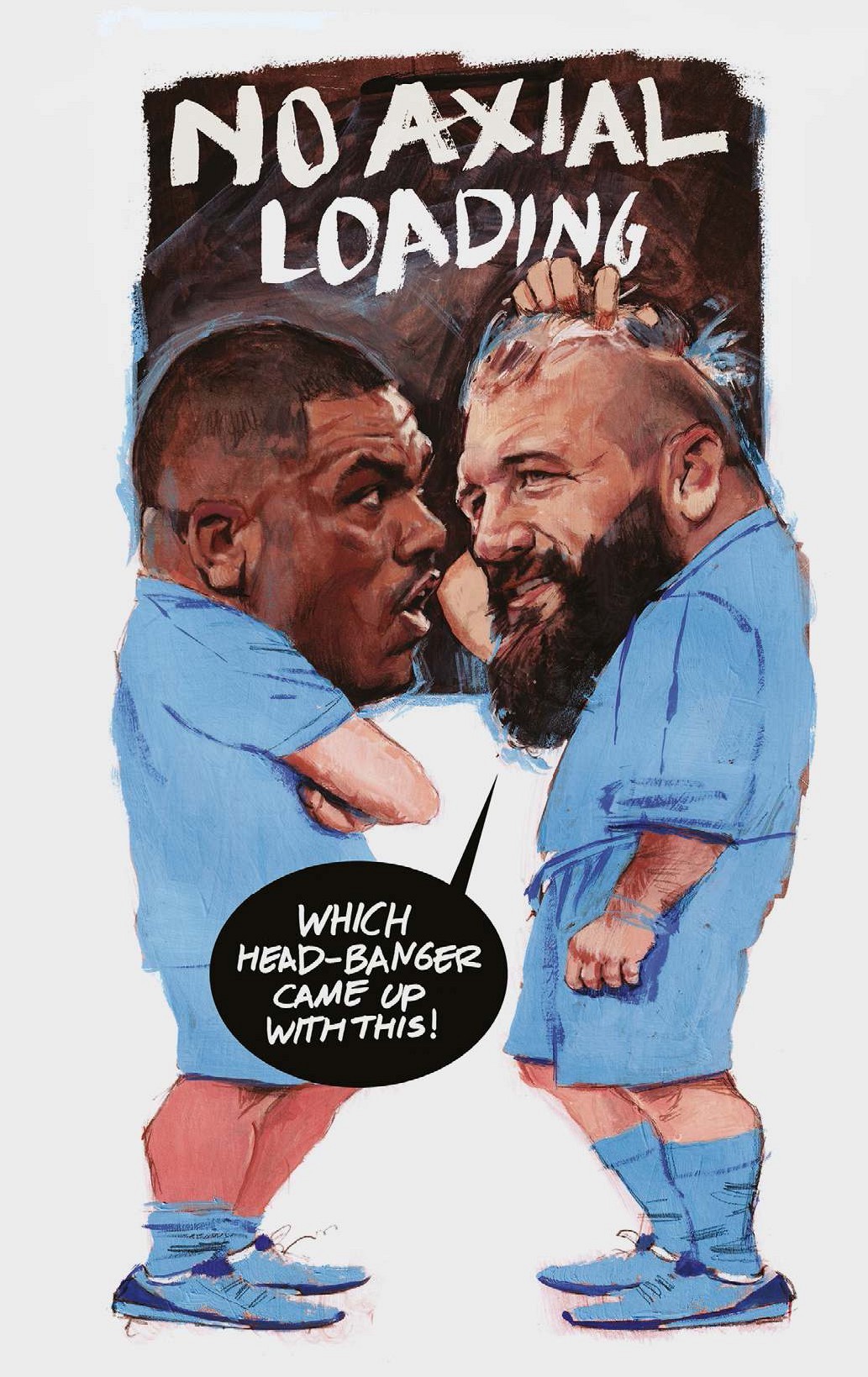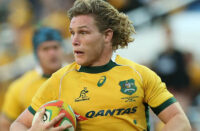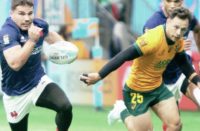
WHEN it comes to timing, World Rugby is like a faulty alarm clock. At the midnight hour, barely two months out from the start of the 2019 World Cup, it has chimed-in with a new scrum law which requires a significant adjustment to the engagement.
This brings with it the prospect of scrums at the World Cup turning into a penalty parade of technical infringements well before the ball is even put-in, with the painfully drawn-out scrum engagement that spectators, and forwards throughout the game, already suffer, becoming even more complicated and convoluted.
The new scrum law has been introduced with the best of intentions – as most bad law-making usually is – as part of a push by World Rugby's Law Review Group (LRG) to reduce the risk of cervical spine injuries to front row forwards when they engage at scrum. World Rugby believes that because the current three-stage scrum call by the referee of ‘crouch – bind – set', introduced in 2013, has led to a significant reduction in scrum injuries, further tinkering could make it even better.
My belief is that the main reason for the reduction is because World Rugby/IRB got rid of the scourge of the ‘hit' engagement, having permitted it for well over a decade. This involved packs operating the hit-and-chase method of scrummaging, where they would come together like rutting stags in an attempt to win the initial engagement. It led to a spike in neck, back and shoulders injuries, and while that has been reduced by the current scrum calls over the last five years, there is no guarantee that the new amendment will make a difference to safety.
It is quite possible that, instead, the new scrum law simply mutates into another problem area for props and hookers. Anybody who witnessed the damage to the scrum, and to player safety, through the ‘hit' engagement, has every reason to be very wary.
You can tell that there is a doctor in the house whenever a medical term like ‘axial loading' – or rotation of the spine – is introduced as part of a decisionmaking process, which is what has happened in the new scrum law with the amendment to Law 19.10b.
This prohibits the current practice of front row forwards placing their heads on the shoulders – and sometimes heads – of the player opposite, between the referee's call of ‘bind' and ‘set'. This is due to fears that it destabilises the scrum on engagement between the two packs before the put-in by the scrum-half, with the potential for serious injuries.
However, unless doctors are scrum experts, they will not always see that the idea of imposing increasingly detailed restrictions on a pushing contest between 16 very powerful, heavyweight forwards, is not only unrealistic, but creates added complications. Here's why. At the moment it is awkward enough with both front rows required to go into a prolonged holding position on the ‘crouch' call, with everyone in their slots before engaging.
The next stage, when the ‘bind' call is made, has seen props and hookers given the responsibility for keeping the scrum apart until the ‘set' –which is effectively a scaled down vision of the old ‘hit' engagement.
“There is the prospect of scrums at the World Cup turning into a penalty parade”
It means that in order to put a brake on the force of their back five propelling them into contact between ‘bind' and ‘set', they jockey for position while still trying to get the jump on their opponents. This has led to props going from using the initial brake of putting their outside arm on the shoulder of the opposite number to keep the scrum apart, to a secondary brake of using their heads to the point of the shoulder.
Hookers also use the head to shoulder method.
It needs emphasising that the force generated by a back five of a pack can be huge, and that the outside arms of two props, however strong, are inadequate when it comes to keeping the scrum apart.
An additional destabilising factor is that props' arms differ in length, meaning that if the bind is long on one side of the engagement process, and short on the other, the scrum will be skewed at the outset. Hence the decision by front row players to use their heads (and spines) instead.
The new scrum law's stipulation that only arms can be used to keep the scrum apart appears flawed because it is unlikely to make any improvements to stability, or safety, and could make it worse.
This is because an arm's length engagement will increase the force of the ‘hit' with the front rows engaging from further away.
What's more it could undermine the World Cup in Japan by marring what should be a sporting spectacular with an ugly rash of scrum penalties which are incomprehensible to most spectators.
Instead, the scrum should be at the centre of the showpiece, as a great trial of strength and technique which pro- duces the best attacking ball a backline can get – as well as the variations of steaming No.8 pick-and-drives, and even push-over tries.
That will only come when there is an outbreak of common sense to solve a scrum fiasco almost entirely of World Rugby/IRB's making. It has to stop the scrum becoming so convoluted and complex, and there is a simple way of doing it, irrespective of whether the call is crouch-bind-set, or the old crouchhold- engage.
THE ONLY THING THAT MATTERS IS FOR THE SCRUM TO BE STATIONARY ON THE MARK BEFORE THE PUT-IN. This means forming and taking the weight so that the scrum is stable and square on the mark, but NOT pushing until the scrum-half puts the ball in STRAIGHT.
Then the hookers strike for the ball, and it is either clean and moved quickly, or the battle for scrum supremacy is on. Until then we will be stuck with variations on the current unholy mess. The scrum, as a defining part of Rugby Union, deserves better than that. duces the best attacking ball a backline can get – as well as the variations of steaming No.8 pick-and-drives, and even push-over tries.
That will only come when there is an outbreak of common sense to solve a scrum fiasco almost entirely of World Rugby/IRB's making. It has to stop the scrum becoming so convoluted and complex, and there is a simple way of doing it, irrespective of whether the call is crouch-bind-set, or the old crouchhold- engage.
THE ONLY THING THAT MATTERS IS FOR THE SCRUM TO BE STATIONARY ON THE MARK BEFORE THE PUT-IN. This means forming and taking the weight so that the scrum is stable and square on the mark, but NOT pushing until the scrum-half puts the ball in STRAIGHT.
Then the hookers strike for the ball, and it is either clean and moved quickly, or the battle for scrum supremacy is on. Until then we will be stuck with variations on the current unholy mess. The scrum, as a defining part of Rugby Union, deserves better than that.
Fiji win will put wind up Gatland
FIJI'S 27-10 victory over the NZ Maori in Suva last weekend has given Wales and Australia, their big gun rivals in World Cup Pool D, a wake-up call.
A Fijian side selected exclusively from French and British clubs, with lock Leone Nakarawa (Racing 92) and flanker Semi Kunatani (Harlequins) leading the way, outclassed the Maori to record their first win over them for 62 years.
They showed their attacking prowess by scoring four tries through full back Alivereti Veitokani (London Irish), No.8 Viliame Mata (Edinburgh), and a brace from big centre Waisea Nayacalevu.
Their 21-14 victory over France in Paris last autumn signalled that Fiji are on the rise, and this result comes with a clear warning to Wales coach Warren Gatland and the Wallaby's Michael Cheika that there could be a giantkiller loose in Pool D.
Even Thor gets mugged in Jo'burg
TANIELA Tupou, the 21 stone Wallaby prop nicknamed the ‘Tongan Thor', found that neither his own muscle, nor that of half a dozen team-mates, was enough to deter a motorised mugger as he walked back from having dinner in Sandton, an affluent gated Johannesburg suburb.
Tupou was ambushed 50 metres from the team hotel by a man in a black hoodie who snatched his mobile from his hand, inflicting minor cuts, and sprinted clear. Having made the walk that Tupou did many times during
England/Lions tours of South Africa I can vouch that walking around with a new iPhone in your hand was very ill-advised – especially in a suburb where criminals are invariably armed. Tupou was dissuaded from giving chase by his Australian mates –which ensured that while he lost his mobile, at least he had the chance of playing against the Springboks.



























